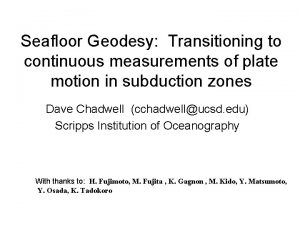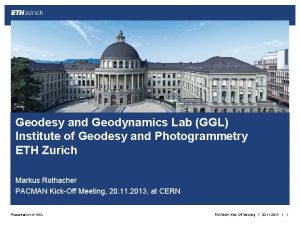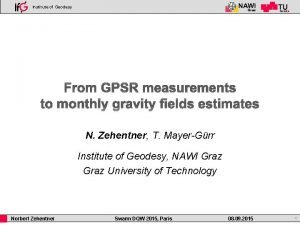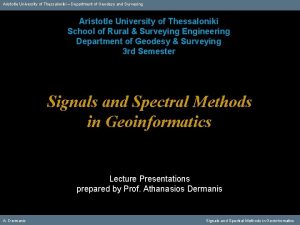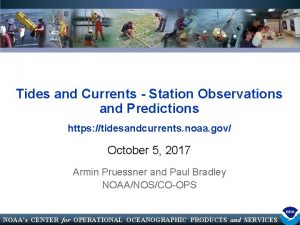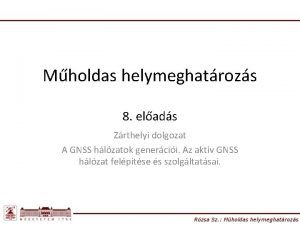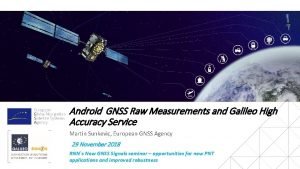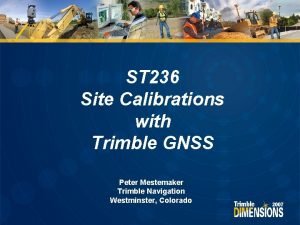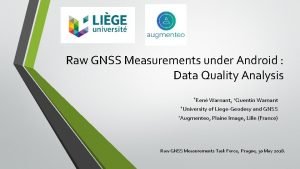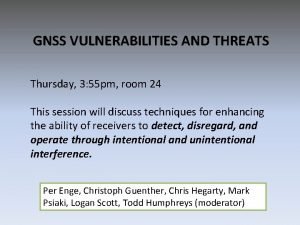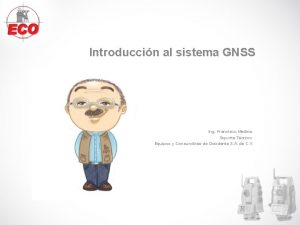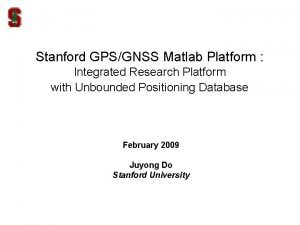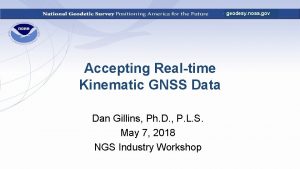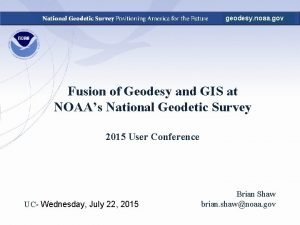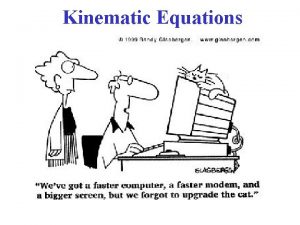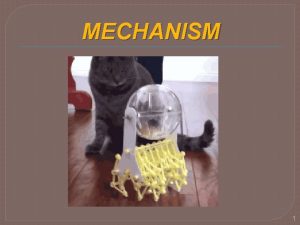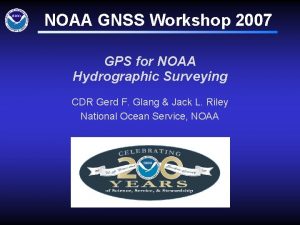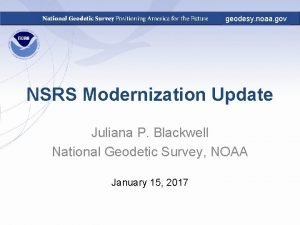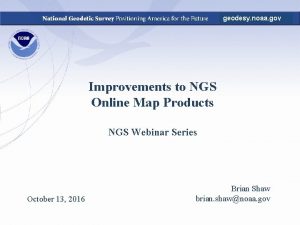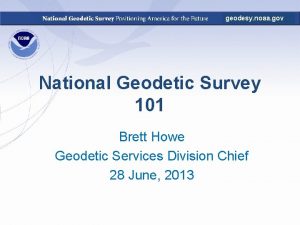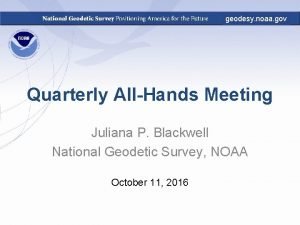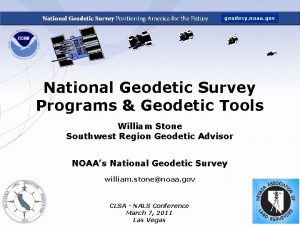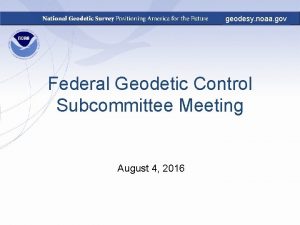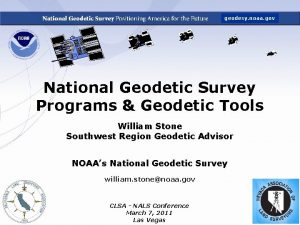geodesy noaa gov Accepting Realtime Kinematic GNSS Data








![Hybrid Static + RTN Survey Networks 9 March 8, 2021 [Weaver et al. 2018] Hybrid Static + RTN Survey Networks 9 March 8, 2021 [Weaver et al. 2018]](https://slidetodoc.com/presentation_image_h/2c2546043bb43698ed7bd7127a63169e/image-9.jpg)









- Slides: 18

geodesy. noaa. gov Accepting Real-time Kinematic GNSS Data Dan Gillins, Ph. D. , P. L. S. May 7, 2018 NGS Industry Workshop

Accuracy vs. Cost • Set a continuous GNSS reference station (i. e. , CORS) – Permanent or semi-permanent base station • Campaign-style static GNSS survey with multiple receivers – Develop survey network for adjustment – OPUS-Projects • Static GNSS survey session with one receiver (i. e. , OPUS-S) • Rapid-static GNSS survey session with one receiver (i. e. , OPUS-RS) • Real-time kinematic (RTK) observation 3 March 8, 2021 Accuracy Cost

Campaign-style GNSS Surveys at NGS • “Height Modernization Surveys” – NOS NGS 58/59 – Establish geodetic coordinates on passive marks – Constrain survey networks to orthometric heights on bench marks to derive orthometric heights on passive marks • “FAA Control Surveys” – AC 150/5300 -16 A – Establish geodetic coordinates on passive marks near runways – Control for airport obstruction surveys

NOS NGS-58 • • Published in 1997 Network hierarchy Repeat observations Survey traceability Adjustments of GNSS network holding control Local accuracy ≤ 2 cm (95% conf. ) Network accuracy ≤ 5 cm (95% conf. )

Real-time Networks (RTNs) • Network of continuously operating GNSS stations – ~ 70 km interstation spacing • Atmospheric and orbital corrections are transmitted to rover via mobile data link • Baselines processed in real-time • Coordinates to cm-level accuracies derived in seconds to minutes

Empirical Evaluation of the Accuracy of RTNs 5 March 8, 2021 [Allahyari et al. 2018]

RTN Surveys Compared to Static Surveys 7 March 8, 2021 Benefits Concerns FAST. Could reduce field observations from several hours to just a few minutes Can evaluate data quality in real time Easy to obtain additional observations Only a single receiver (i. e. , rover) is needed during a session RTN may not be aligned with the National Spatial Reference System Ideally, survey should be tied to CORS Network More prone to multipathing errors Baselines must be kept short (i. e. , < 40 km)

Methods for Receiving Corrections from an RTN Virtual Reference Station (VRS) Master-Auxiliary Concept (MAC) • Vector “tails” connected to physical base station • Base station position is fixed • Vector “tails” referenced to virtual base station—can be moved to physical ref. station (PRS) RTN Base VRS Control Center 8 March 8, 2021 (Landau et al. 2002) RTN Base (Leica 2005)
![Hybrid Static RTN Survey Networks 9 March 8 2021 Weaver et al 2018 Hybrid Static + RTN Survey Networks 9 March 8, 2021 [Weaver et al. 2018]](https://slidetodoc.com/presentation_image_h/2c2546043bb43698ed7bd7127a63169e/image-9.jpg)
Hybrid Static + RTN Survey Networks 9 March 8, 2021 [Weaver et al. 2018]

Example: Conduct RTN Survey

Example: Download RTN Data BASE (LCS 1)

Example: Process Static Data in OPUSProjects Upload Vectors

Example: Upload RTN Vectors to OPUSProjects LEGEND CORS User Mark Processed Vector (OPUS-Projects) Uploaded Vector Upload Vectors

Example: Adjust Static + RTN Network • Run least squares adjustment(s) of the combined static data and RTN vectors in the survey network • Hold CORS (and possibly other published coordinates on passive marks) as control in network adjustments • Check quality of results • Submit survey project to NGS for review and publication in national database

Network Accuracy at Marks in Hybrid Network vs. Number of Independent RTN Observations (Each real-time vector based on a 5 -minute (300 -epoch), fixed observation; GPS+GLONASS) 15 March 8, 2021

“Standardized GNSS Vector Exchange Format” Must Have: • Mark-to-mark ECEF vector components (d. X, d. Y, d. Z) • Standard deviations of vector components • Correlations or covariances • Reference frame • Start and stop time of observation • A-priori coordinates of the “from” station

“Standardized GNSS Vector Exchange Format” Should Have: • • Equipment information (at both “from” and “to” station) Number of satellites used (GPS vs. GLONASS vs. Galileo vs. Beidou) DOP Solution type (fixed vs. float) Orbit source Observer name or ID RTN metadata – Name of RTN; network type – inside/outside network – Mount point; data format; IP address; IP port – RTCM age

Summary • Real-time kinematic GNSS data are sufficiently accurate for many geodetic surveying applications – Must balance accuracy versus efficiency • Developing tools in OPUS-Projects so surveyors can upload, include, and adjust vectors from real-time GNSS surveys – Need a standardized GNSS vector exchange format for industry • Developing new surveying guidelines and/or specifications for including real-time data in a GNSS geodetic control survey
 Geodesy and geomatics engineering
Geodesy and geomatics engineering Seabed geodesy
Seabed geodesy Branches of geodesy
Branches of geodesy Institute of geodesy and photogrammetry
Institute of geodesy and photogrammetry Space geodesy facility
Space geodesy facility Geodesy
Geodesy Geodesy
Geodesy Tidesandcurrents
Tidesandcurrents Noaa epirb registration
Noaa epirb registration Www noaa gov
Www noaa gov Realtime big data
Realtime big data Gnssnet
Gnssnet Three segments that make up a gnss
Three segments that make up a gnss Pnt
Pnt Trimble site calibration
Trimble site calibration Android force full gnss measurements
Android force full gnss measurements Gnss vulnerabilities
Gnss vulnerabilities Sistemas de aumentacion gnss
Sistemas de aumentacion gnss Gnss gps
Gnss gps

